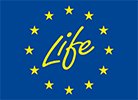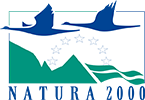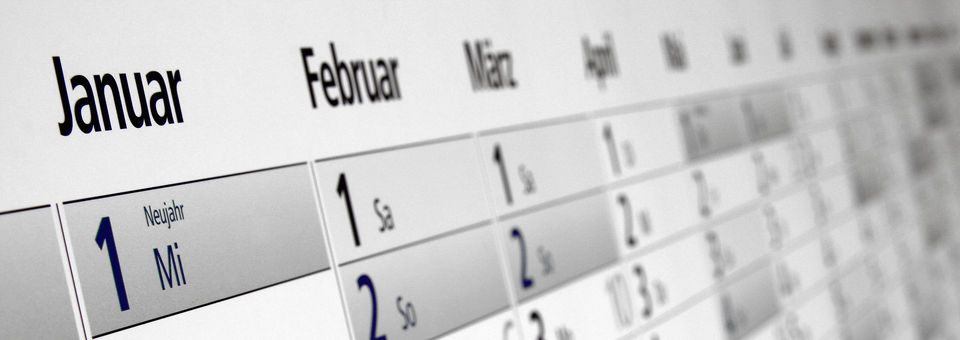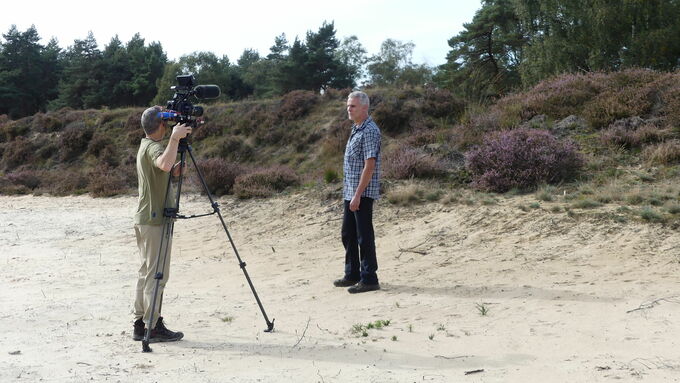Filming in the nature reserve ‘Brachter Wald‘ © Bezirksregierung Münster
main content
Project of the month
#3/2024 PROJECT FILMS
LIFE IP actions in sound and vision
Public relations are an important aspect of the LIFE IP Atlantic Region DE. They help to raise public awareness of the loss of biodiversity in the region and to highlight the measures required to reverse the trend. Last but not least, the aim is to increase understanding and acceptance of the implementation measures, as the underlying nature and species conservation objectives are not always apparent in the sometimes quite severe on-site work. Communication via various media such as press releases and other publications, information boards and an extensive website can help to explain the background to the public and mediate between possible conflicts of interest.
The production of short films is another supporting tool for public relations. In various contributions, the subjects of protection and their ecological significance can be presented and the threats and the need for restoration measures can be emphasised.
In the second phase of the project, three actions had already been accompanied on film:
- The first film presents the actions taken to restore inland dunes in the nature reserves ‘Heidemoore’ (C24) and ‘Brachter Wald’ (C23 and C25) in the district of Viersen. Open inland dunes were restored as a habitat for typical dune plants and species such as the sand lizard and the smooth snake. The biological station ‘Krickenbecker Seen’ took over the supervision of the technical implementation together with the Lower Nature Conservation Authority of the district of Viersen.
- Another film presented the actions to restore the inland dunes ‘Sellhorn’ in the Lüneburg Heath (C78, C79, C83), which were carried out by the NLWKN in cooperation with the Lower Saxony State Forests.
- The film ‘Eine Chance für die Knoblauchkröte’ (a chance for the common spadefoot toad) explains the breeding (A2) and reintroduction of the common spadefoot toad along the river Lippe (C14-C16, C106-C109, C117, C162). These measures were carried out in cooperation with the NABU nature conservation station Münsterland and ABU Soest.
For the third and fourth project phases, the production of a project image film and up to eight further thematic short films were put out to tender as a complete package. The bids received were assessed using an evaluation matrix and a framework contract was then concluded with the resulting contractor.
The first commission was aimed at documenting the 4th Atlantic Biogeographical Seminar[RDM1] which took place in Hanover in September 2023 and was jointly organised by the European Commission's Directorate-General for the Environment, the Ministry for the Environment, Energy and Climate Protection of Lower Saxony and the LIFE IP Atlantic Region DE. Short interviews on Natura 2000, the LIFE programme and the LIFE IP were conducted with some of the approximately 100 participants from ten countries:
- Ssymank, German Federal Agency for Nature Conservation (BfN), Head of Division II 2.2 Habitats Directive | Natura 2000 (external link opens in a new window)
- Frank Vassen, EU Commission Directorate General Environment (external link opens in a new window)
- Christian Michalczyk, Authority for the Environment, Climate, Energy and Agriculture, Hamburg (external link opens in a new window)
- Dr. Stefan Heitefuss, Lower Saxony Ministry for the Environment, Energy and Climate Protection, Unit 62: Natura 2000, nature reserves (external link opens in a new window)
- Tom Andries, Agentschap voor Natuur en Bos, project manager of the Belgian integrated LIFE projects (B4B and BNIP) (external link opens in a new window)
Another documented special event was the species knowledge seminar in the Lüneburg Heath in July 2023 which was organised by ‘Verein Naturschutzpark Lüneburger Heide’ (Lüneburg Heath Nature Conservation Park Association) and supported by the LIFE IP and the Lower Saxony BINGO Environmental Foundation. Over 35 participants were introduced to various species groups through lectures, identification exercises and excursions and recorded about 1000 species in the field.
Further films are to be produced in the course of 2024 and 2025, for example on the topics of bogs, heathland ponds and amphibians in North Rhine-Westphalia and on the actions at the ‘Silbersee’ and for amphibians (with a focus on the natterjack toad) in Lower Saxony.




